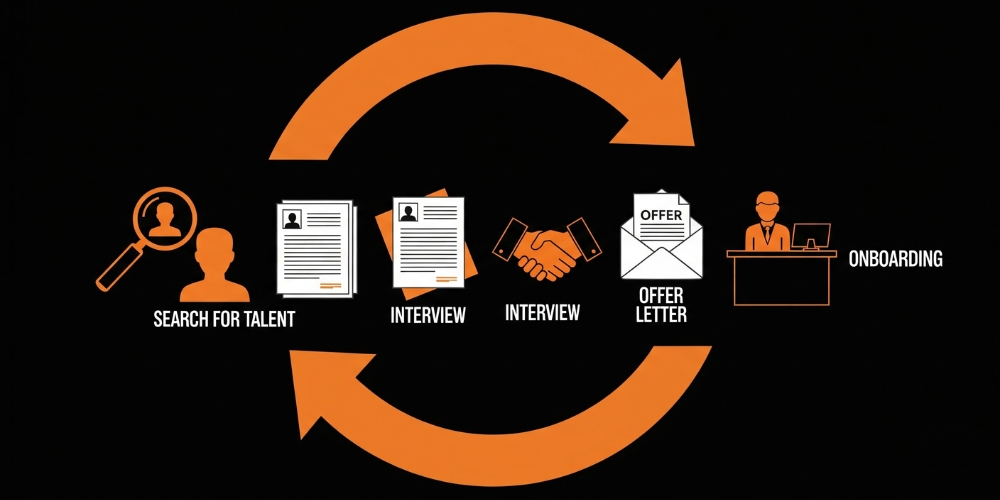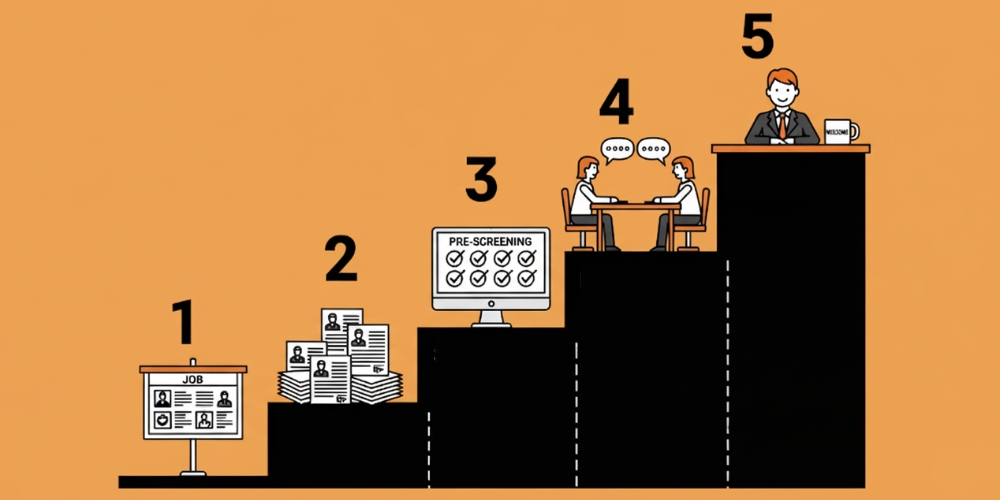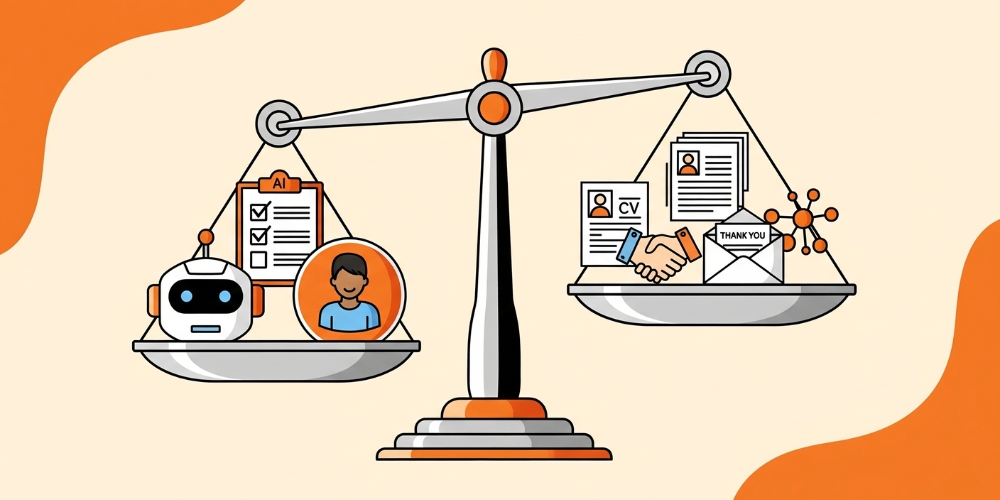Everything You Need to Know About the Recruitment Process

TL;DR
- The recruitment process is how companies find, attract, and hire people.
- Stages: job posting, pre-screening process, interviews, selection process.
- Candidates should tailor resumes, prep for interviews, and follow up.
- Recruiters should write clear job ads, track metrics, give feedback, and use AI.
- Knowing the difference between recruitment meaning vs. selection helps both sides.
Companies often lose time, money, and good candidates because the recruitment process is murky, slow, or unfair. Some job seekers get ghosted. Some roles stay open for months. Sometimes the hiring team ends up with the wrong fit. These issues happen when the steps in recruitment are poorly defined or inconsistent.
In this blog, you will learn what the recruitment process actually means, how it works from both recruiter and candidate views, and what practices improve its outcomes. By the end, you’ll know tools, tips, and examples (including a recruitment process example) that help everyone from HR managers to job seekers.
Recruitment Horror Stories True or False?
Guess if each short story is true or false. Click to lock your answer. Then press Check answers.
About these stories
These are drawn from real hiring anecdotes and common scenarios. Use them to spark discussion in the article intro.
What Is the Recruitment Process?

When someone says recruitment process in HRM, they mean the entire pathway from identifying a role that needs filling, all the way to hiring someone. It includes attracting people, screening them, selecting the right one, and onboarding. HRM stands for Human Resource Management, and it’s the system inside organizations that handles this.
Here are some key definitions
- Recruitment meaning: attracting and encouraging qualified people to apply for a job opening. It’s about getting the word out.
- Selection process: after applications come in, deciding which candidates best fit the job, and then offering the role.
Other related terms:
- Talent acquisition process tends to be broader. It might include planning ahead so the organization always has good people ready.
- Candidate selection process is part of the selection process, specifically how you decide who moves forward among applicants.
Why this matters: In 2025, employers globally report spending an average of 44 days to fill a role. That’s often because of delays in screening, interviewing, and deciding. Also, 72% of employers say finding qualified candidates is hard.
The Key Stages of the Recruitment Process

Below are the main steps most organizations follow. Each stage matters in making the recruitment fair, fast, and effective.
The Key Stages of the Recruitment Process
| Stage | What Happens |
|---|---|
| Job Analysis & Planning | Identify need, define role, skills, budget, timeline. |
| Sourcing/Attraction | Share job ads, employer branding, use networks, social media and referrals. |
| Pre-Screening | Review applications, use pre-screening process tools such as questionnaires and resume filters and eliminate unfit applicants. |
| Interviewing/Assessment | Conduct structured interviews, tests and assessments. Sometimes multiple rounds. |
| Selection | Choose the best fit via the selection process then make a job offer and negotiate terms. |
| Onboarding | Help new hire adjust with paperwork, training and integration into the team. |
Some organizations add a post-hire review to see if the hire meets expectations.
A few facts about these stages:
- On average, it now takes about 50 days to fill an open position across industries. That includes planning, sourcing, screening, interviewing, and making an offer.
- For high-demand roles, time-to-fill is rising: many companies report 44 days in recent research.
The Recruitment Process From a Candidate’s Perspective

When you apply for a job, you see this process mostly from the other side. Here’s how it typically feels, and what matters most to you.
The Candidate’s Journey
- Seeing the Job Listing
You read the job description, skills required, and company culture. Clear language helps.
- Applying
Fill the application form, attach a resume, and maybe a cover letter. Sometimes there is an online test.
- Pre-Screening / Shortlisting
Recruiters or AI tools check your resume, your qualifications, and maybe some automated screening. If you pass, they invite you to interview.
- Interview/Assessment
Could be a phone/video call, technical test, or in-person interview. You meet people who ask about your experience, skills, and sometimes values.
- Decision & Offer
If you’re selected, the recruiter makes an offer. If not, you might get rejection or no reply.
- Onboarding (if you accept)
You start work, train, meet your team, and learn workflows.
What Candidates Care About
- Speed: 57% of job seekers lose interest if hiring takes too long.
- Communication: In many surveys, substantial numbers of candidates abandon or dislike the recruitment process because they received no feedback or updates.
- Transparency: 47% say that knowing the salary range and job expectations early improves trust.
Challenges Candidates Face
- Being ghosted (no response after interviews).
- Vague job descriptions.
- Multiple rounds with redundant assessments.
- Long waiting periods with no updates.
If recruiters do better in these areas, the candidate experience improves and more offers are accepted.
Candidate Journey Simulator
Make choices like a job seeker and see how your journey changes.
Step 1: How do you apply?
The Recruitment Process From a Recruiter’s Perspective

Recruiters see many moving parts. Below is how they view the process, the pressures, and what they try to measure.
Recruiter Responsibilities & Tasks
- Clarify what the role needs (skills, fit, timeline).
- Write or approve job ads/job descriptions.
- Source candidates (ads, referrals, social media, recruiters).
- Run the pre-screening process: filter resumes, sometimes use AI tools.
- Coordinate interviews and assessments.
- Do the selection process: compare candidates, consult hiring managers, and decide.
- Once selected, make an offer and manage onboarding.
What Recruiters Track
They use metrics (so they know where the bottlenecks are, what works, what doesn’t):
Key Recruiting Metrics
| Metric | Why It Matters |
|---|---|
| Time-to-fill / Time-to-hire | Shows speed and efficiency. Delays cost money and risk losing top candidates. |
| Quality of hire | How well candidates perform after being hired. |
| Application-to-hire conversion rate | How many applicants turn into hires? |
| Cost per hire | Budget control. |
| Candidate satisfaction/experience | Bad experiences harm the employer brand; good ones help referrals and retention. |
Challenges for Recruiters
- High volume of applications (many irrelevant).
- Balancing speed with fairness.
- Ensuring diversity, avoiding bias.
- Keeping candidates informed without overburdening.
- Managing expectations: salary, skills, timeline.
Goals & Best Outcomes
- Make the talent acquisition process smoother so good candidates stay engaged.
- Use tools (like applicant tracking systems, structured interviews) so things are fair.
Improve the interview process so decisions are more data-driven, less gut feeling.
Best Practices for an Effective Recruitment Process

The recruitment process is easier to get right when both sides play smart. Here’s what matters most.
For Recruiters/Employers
Use AI tools to speed up screening.
AI doesn’t replace recruiters, but it reduces grunt work. Smart systems can sort resumes, spot keywords, and even rank candidates. This frees up time to focus on interviews and culture fit.
Prioritize candidate experience with timely feedback.
Ghosting damages reputation. Even a short rejection note is better than silence. A structured communication flow keeps candidates engaged and prevents drop-offs. Research shows positive candidate experiences improve the chance of offer acceptance and future referrals.
Write inclusive job descriptions.
Avoid jargon, gendered language, and vague requirements. Inclusive postings attract more qualified applicants, especially from underrepresented groups. Clear job ads also reduce confusion during the candidate selection process.
Track hiring metrics.
Measure time-to-fill, cost per hire, and quality-of-hire. If you notice delays in the pre-screening process or repeated drop-offs during interviews, it’s a signal to improve. Keeping track makes the entire talent acquisition process smoother.
For Job Seekers
Tailor resumes to job descriptions.
Recruiters spend seconds on each application. Highlight the skills mentioned in the ad. A tailored resume beats a generic one every time.
Prepare for structured interviews.
Companies are moving away from casual chats. Expect job-related, behavior-based, or technical questions. Prepare examples that show results and measurable impact.
Follow up with thank-you notes.
After interviews, a quick thank-you email shows professionalism. It’s a small action that leaves a strong impression.
Leverage networking to bypass filters.
Not every opportunity is posted. Networking can open doors and bypass the bottlenecks of automated filters. Connections on professional platforms or alumni groups often bring interviews faster than cold applications.
Conclusion
The recruitment process isn’t just paperwork or an HR routine. It’s how organizations secure the right people and how candidates land the right opportunities. When recruiters use clear steps, fair screening, and respectful communication, they attract stronger talent. When job seekers approach the process with preparation and persistence, they stand out.
Getting recruitment right benefits everyone: the company saves time and resources, and candidates find roles where they can grow. Whether you’re an employer building a team or a job seeker chasing the next big opportunity, the lessons here give you a roadmap to succeed.
FAQs
It varies. Simple roles can take a couple of weeks while specialized positions may stretch into months. Time depends on job level, applicant volume and company efficiency.
Recruitment is about attracting people to apply. Selection is about choosing the best fit from those applicants. Recruitment fills the funnel while selection filters it down.
AI helps automate tasks like resume screening, scheduling and candidate matching. It doesn’t replace human judgment but saves time and reduces bias when used correctly.






